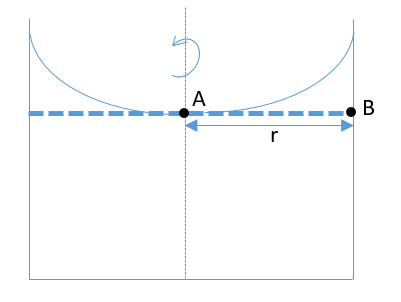
A cylindrical vessel partially filled with water is rotated about its vertical central axis, it's surface will
A. Rise equally
B. Rise from sides
C. Rise from the middle
D. Lowered equally
Answer
221.7k+ views
Hint:When a body is rotated about an axis then there is centripetal acceleration acting towards the center of the circular path described by the rotatory motion. The fluid pressure at the same horizontal level is equal.
Formula used:
\[P = \rho gh + \rho al\]
Where P is the fluid pressure at depth h from the surface of the water in an accelerated container with acceleration a and the distance from the center is $l$.
\[{a_c} = {\omega ^2}r\]
Here \[\omega \] is the angular speed with which the cylinder is rotated.
Complete step by step solution:
When a cylindrical vessel which is partially filled with water is rotated then the total pressure at the bottom of the container is due to fluid pressure, atmospheric pressure and the centripetal force acting per unit area.

Image: A rotating cylinder with water
Taking two points on the same horizontal level. When the cylinder is rotated about its own axis then the centripetal force will act towards the center of the cylinder. The centripetal acceleration is given as,
\[{a_c} = {\omega ^2}r\]
Then the pressure at point A will be,
\[{P_A} = {P_0}\]
And the pressure at point B will be,
\[{P_B} = {P_0} - {\omega ^2}r\]
As both the points are on the same horizontal level, so the pressure at both the points at equilibrium must be the same. To balance the pressure, the water will rise above the horizontal level so that there is extra pressure due to fluid. And hence, the water surface will take a concave upward shape, i.e. the water will rise from the sides.
Therefore, the correct option is B.
Note: When the cylinder is at rest then the surface of the water will be horizontal so that every point on the same horizontal level has the same pressure. Moreover, the measurement of the force per unit area on an item on the surface of a closed container or in the fluid is known as fluid pressure. This pressure is brought on by acceleration, gravity, or external forces in closed containers.
Formula used:
\[P = \rho gh + \rho al\]
Where P is the fluid pressure at depth h from the surface of the water in an accelerated container with acceleration a and the distance from the center is $l$.
\[{a_c} = {\omega ^2}r\]
Here \[\omega \] is the angular speed with which the cylinder is rotated.
Complete step by step solution:
When a cylindrical vessel which is partially filled with water is rotated then the total pressure at the bottom of the container is due to fluid pressure, atmospheric pressure and the centripetal force acting per unit area.

Image: A rotating cylinder with water
Taking two points on the same horizontal level. When the cylinder is rotated about its own axis then the centripetal force will act towards the center of the cylinder. The centripetal acceleration is given as,
\[{a_c} = {\omega ^2}r\]
Then the pressure at point A will be,
\[{P_A} = {P_0}\]
And the pressure at point B will be,
\[{P_B} = {P_0} - {\omega ^2}r\]
As both the points are on the same horizontal level, so the pressure at both the points at equilibrium must be the same. To balance the pressure, the water will rise above the horizontal level so that there is extra pressure due to fluid. And hence, the water surface will take a concave upward shape, i.e. the water will rise from the sides.
Therefore, the correct option is B.
Note: When the cylinder is at rest then the surface of the water will be horizontal so that every point on the same horizontal level has the same pressure. Moreover, the measurement of the force per unit area on an item on the surface of a closed container or in the fluid is known as fluid pressure. This pressure is brought on by acceleration, gravity, or external forces in closed containers.
Recently Updated Pages
Uniform Acceleration Explained: Formula, Examples & Graphs

JEE Main 2022 (July 26th Shift 1) Physics Question Paper with Answer Key

JEE Main 2022 (June 26th Shift 2) Chemistry Question Paper with Answer Key

Apparent Frequency Explained: Formula, Uses & Examples

JEE Main 2023 (January 30th Shift 2) Chemistry Question Paper with Answer Key

JEE Main 2023 (April 15th Shift 1) Physics Question Paper with Answer Key

Trending doubts
JEE Main 2026: Application Form Open, Exam Dates, Syllabus, Eligibility & Question Papers

Derivation of Equation of Trajectory Explained for Students

Hybridisation in Chemistry – Concept, Types & Applications

Understanding the Angle of Deviation in a Prism

How to Convert a Galvanometer into an Ammeter or Voltmeter

Degree of Dissociation: Meaning, Formula, Calculation & Uses

Other Pages
Thermodynamics Class 11 Physics Chapter 11 CBSE Notes - 2025-26

JEE Advanced Marks vs Ranks 2025: Understanding Category-wise Qualifying Marks and Previous Year Cut-offs

Units And Measurements Class 11 Physics Chapter 1 CBSE Notes - 2025-26

NCERT Solutions For Class 11 Physics Chapter 8 Mechanical Properties Of Solids

Motion in a Straight Line Class 11 Physics Chapter 2 CBSE Notes - 2025-26

Laws of Motion Class 11 Physics Chapter 4 CBSE Notes - 2025-26




